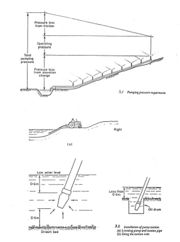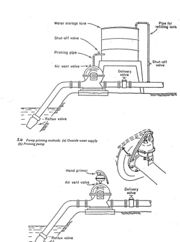Design and Management of Irrigation Systems
Contents
What is Design and Management of Irrigation Systems?
- Knowledge in the Design and Management of Irrigation Systems is of great importance to ensure that our irrigation projects are sustainable. With the increasing competition for water resources, it is imperative that irrigation uses water in the most efficient manner. This can only be ensured by a well designed irrigation system coupled with the proper training of users. It is therefore necessary to train engineers to design irrigation systems which are efficient and cost effective. This course will tackle all aspects of irrigation system design for all currently known irrigation systems starting from feasibility studies, evaluation of resources, preliminary irrigation system design, detailed irrigation system design, prepation of irrigation design documents, prepartion of bill of quantities, evaluation of alternatives, environmental impact assessment, operation and maintenance of irrigation systems and development of monitoring and evaluation tools for irrigation projects.
|
At the end of this course the student should have learned how to:
|
About the Course
The course takes 14 weeks with a minimum of 6 hours per week. It is structured in such a way that there is an introduction, objectives and a detailed presentation of different chapters, a summary and an evaluation after every chapter. The student is expected to attempt the questions. The design questions are submitted at the end of the course.
New Terminologies
- Feasibility studies - a study carried out assess whether the resources in an area warrant the development of the project
- Preliminary design - Initial designs made to asses and evaluate the different project alternatives
- Bill of Quantities - A listing showing the materials and works needed to implement the project. This list is used for tendering
- Environmental impact assessment - an assessment of the positive and negative impacts of the project to the environment and the mitigation measures to minimize the negative impacts
Chapter 1: Feasibility Studies
Topics in this chapter include:
- Identification and evaluation of water resources
- water quantities
- water qualities
- water availability
- Identification and evaluation of land resources
- soils and their properties
- land topography
- land tenure
- Agronomy
- feasible crops and their features
- crop water requirements
- Human resources
- water associations
- technical manpower
- Evaluation of resources
Chapter 2: Preliminary Design
Inventory of resources
- Size, shape, slope, topography of the area to be irrigated. A map with contours is necessary.
- Water sources: availability, dependability, location, quality, water rights.
- Agriculture: crops to be grown, expected yields, special cultural practices, spacings, seasons, sensitivity to water stress, rooting, fertilization, crop factors.
- Climate: rainfall, crop water requirements, irrigation requirements, growing season.
- Soils: physico-chemical properties, soil depth, rootability, infiltration rate, water holding capacity, salinity, alkalinity, susceptibility to slaking.
- Availability and cost of electric power and or diesel/petrol fuel for engines, possibility/need for a generator, reliability of power supply.
- Availability of pumps, engines, motors, and sprinklers system components in the local market, costs.
- Availability and cost of skilled labour to operate and maintain the system properly.
- Availability of money for initial investment (loan?) and operating expenses.
Layout of the system
- Make a basic choice of the type of system from: conventional, mobile, rainguns, spray lines, mobile lateral system. In this case choose the conventional system.
- Decide whether portable, semi-portable, semi-permanent, solid set or permanent.
- The shape of the field and location of the water source often suggest a logical layout, with the shortest possible main, and the minimum number of laterals and sprinklers combined with the minimum number of shifts.
- Place main lines up or down the principal slope of the terrain
- Sprinkler laterals should be at right angles to the principal slope or slightly down for flushing and gaining some head.
- Sprinkler laterals should be at right angle to the prevailing winds.
- Avoid long laterals; shorter ones give more uniform distribution through more even pressures and allow for small diameter pipes.
- The water source should be as near to the centre of the field as possible, the main being laid through the centre of the longer side of a rectangular field.
- If laterals are taking off from the two sides of a main, minimum labour and time is spent in moving if laterals make a full ‘round’.
Engineering and hydraulic design
The engineering and hydraulic design is concerned with water requirements, irrigation interval, application rates, choosing a sprinkler type, spacing of sprinklers and laterals and calculating pipe diameters and pumping requirements. The steps may be outlined as:
- Determining the depth of water to be applied per irrigation from the irrigation requirements, the readily available moisture data, the effective rooting depth and the expected irrigation efficiency.
- Determine the convenient irrigation time. Day and night irrigation is often used to make optimum use of the equipment (and because of low evaporation losses at night). A twice-daily shift is convenient (early morning and late afternoon), thus allowing for 11 hours application time per setting. The minimum duration for a setting is determined by the minimum infiltration rate of the soil. The sprinkler application rate should never exceed the intake rate.
- Choose a sprinkler type, which fits the application rate from available manufacturer's data. In this case choose a medium pressure (2-4 bar) rotation sprinklers with a normal angle (30), single or double jet following from the chosen rain intensity.
- From the approximate layout of the mains and laterals and the selected sprinkler, opt for an average nozzle size and an average operating pressure and find the recommended spacing from the manufacturer's data sheet.
- Calculate how many sprinklers should operate at the same time to cover the entire area in the required interval. This will give you the total length of laterals required.
- From the number of sprinklers operating simultaneously and the discharge per sprinkler (manufacturer's data), calculate the total system capacity. Determine also the discharge per lateral.
- Determine the required size of the main line. This determined form the system discharge, Q, and the allowable friction losses, and availability in the market. A practical guideline is to limit the frictional losses to not more than 15% of the pressure at the pump. Select also the pipe strength (class). Terrain elevation and possible lateral positioning should be considered.
- Determine the size of the laterals. The pressure fluctuation in the lateral should be limited to 20% of the selected operating pressure for the sprinkler. This limits the discharge fluctuation to 10%. Since a lateral has multiple outlets along its length, the frictional head loss is, Christiansen's adjustment factor is used to modify the calculated friction losses for a plain pipe.
- Determine the total dynamic head. One normally starts from the farthest sprinkler on the farthest lateral. Take the design operating pressure at the nozzle, add the riser height, add the friction loss in the lateral, add friction loss in the main and add the elevation difference between the water supply level and the terrain. This will provide the total dynamic head H.
- Calculate the power requirement of the engine/motor. The water power is found from:
for Q (m3/s), H (m), g (m2/s) and (kg/m3). Apply the efficiencies of the engine/motor, the transmission and the pump and find the input power required. Apply corrections for altitude, temperature, sediment load, continuous full load operation to find the gross nominal required power.
- These steps may have to be repeated a number of times until a satisfactory combination of variables has been obtained.
Estimating costs
After the full hydraulic engineering design has been made, the remaining bill of quantities and the cost estimate should not be a problem. Some difficulties may arise from assumed or designed materials not being available, which may necessitate repeating the calculations with the availability in mind. The following steps can be distinguished:
- Based on the provisional design, prepare a detailed design layout, indicating length of pipes, diameters, risers, valves, bends, and all kinds of other accessories.
- From this detailed design drawing, prepare a bill of quantities for obtaining quotations for the whole system and make estimates of costs other than direct sprinkling equipment (pump house, right of way for buried main line, extension of power line, protection, cost of installation, etc.
- Obtain quotations from different suppliers and compare among them and with your budget. See if you can find any savings in your design; otherwise adjust the area, if necessary.
Lateral hydraulics
Usually a lateral is made of aluminium or plastic, and has multiple outlets with even sections. The pipe is characterized by a continuous decline in water discharge along the pipe. The flow rate starts at Qu at the upstream end and ends up with qs downstream (equal to the discharge of a single sprinkler). The calculation of the head loss is done in two steps: o The head loss is calculated by assuming the pipe is plain (no outlets) o The outcome is multiplied by the coefficient F (Table 2). The value of F depends on the number of outlets, n, along the lateral pipe and the location of the first outlet.
The energy loss in pipes is due to water flow is proportional to the pipe length. The Hazen-Williams equation is one of the most common equations used in calculating the frictional head loss. The equation is expressed as:
k1= conversion constant (Table 1) hf= friction head loss expresses (m) Q= flow rate (L3/T) D= pipe diameter (L) C= Hazen-Williams coefficient (range: 100-150)

